Intel Z77 Motherboard Review with Ivy Bridge - ASRock, ASUS, Gigabyte, and MSI
by Ian Cutress on May 7, 2012 7:40 PM EST- Posted in
- Motherboards
- MSI
- Gigabyte
- ASRock
- Asus
- Ivy Bridge
- Z77
Power Consumption
Power consumption was tested on the system as a whole with a wall meter connected to the OCZ 1250W power supply, while in a dual 7970 GPU configuration. This power supply is Gold rated, and as I am in the UK on a 230-240 V supply, leads to ~75% efficiency > 50W, and 90%+ efficiency at 250W, which is suitable for both idle and multi-GPU loading. This method of power reading allows us to compare the power management of the UEFI and the board to supply components with power under load, and includes typical PSU losses due to efficiency. These are the real world values that consumers may expect from a typical system (minus the monitor) using this motherboard.
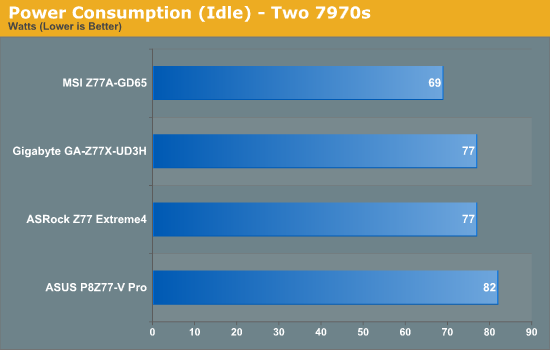
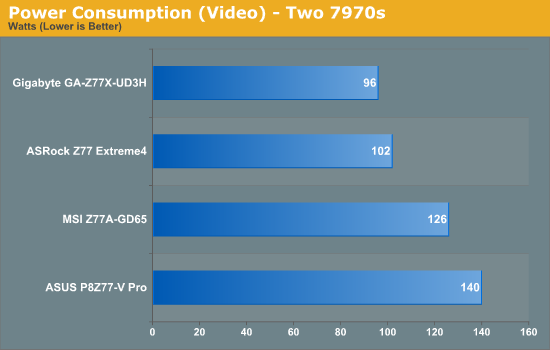
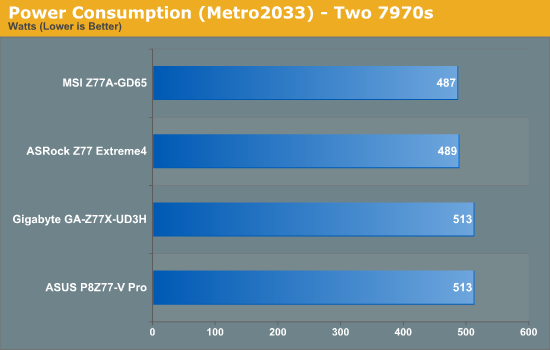
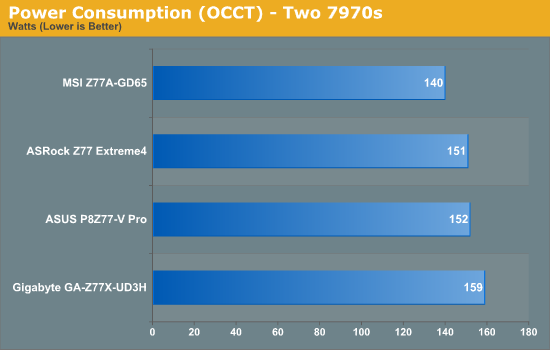
Perhaps the alarming graph of these is the power draw under video performance. It seems that certain motherboard BIOSes consider it a more intensive task, waking up more of the processor (or GPU) to compensate. At load however, we see the MSI and the ASRock boards drawing less power overall.
Boot Times
Different motherboards have different POST sequences before an operating system is initialized. A lot of this is dependent on the board itself, and POST boot time is determined by the controllers on board (and the sequence of how those extras are organized). As part of our testing, we are now going to look at the POST Boot Time - this is the time from pressing the ON button on the computer to when Windows starts loading. (We discount Windows loading as it is highly variable given Windows specific features.) These results are subject to human error, so please allow +/- 1 second in these results.
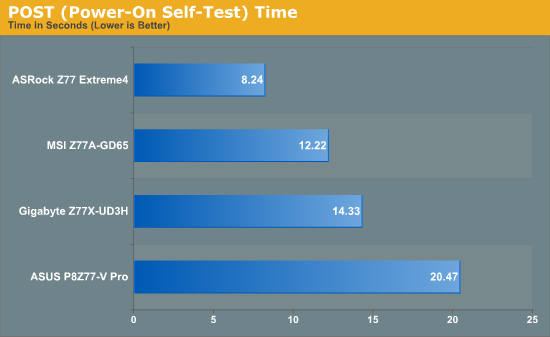
With a lot more controllers to initialise on board, the ASUS P8Z77-V Pro requires at default 20.47 seconds to reach the windows loading screen. By disabling controllers that aren't used, a time more like the ASRock could be achieved. There is direct correlation between functionality and POST time.
Overclocking
Here at AnandTech we want to provide quick and easy ways to determine if a board is good for you (with in-depth analysis of course). So here is a quick round up of our overclocking results. Overclocks are tested for stability with PovRay and OCCT - while these may not be the most strenuous of stability tests, it does offer a quick check for memory errors under high load (and also balances testing time with getting the next board on for review!).
|
CPU Speed (MHz) |
Voltage (Volts) |
PovRay Peak Temp (ºC) |
OCCT Peak Temp (ºC) |
Notes | |
|
ASRock Z77 Extreme4 |
4700 | 1.175 | 86 | 86 | LLC Level 1 |
|
ASUS P8Z77-V Pro |
4700 | 1.200 | 83 | 86 | PLL Overvoltage enabled |
|
Gigabyte Z77X-UD3H |
4700 | 1.200 | 82 | 86 | LLC Extreme |
|
MSI Z77A-GD65 |
4700 | 1.250 | 90 | - | PLL Overvoltage enabled |










117 Comments
View All Comments
bji - Tuesday, May 8, 2012 - link
Don't intelligently designed modern operating systems use as much unused RAM as is available as filesystem cache? I know Linux does, I would expect Windows 7 does as well. In which case, I have to wonder what the value of a RAM disk except to make your persisted data completely volatile and lost on a power outage.Turning the unusable RAM beyond 4 GB into a RAM disk when a 32 bit operating system is in use is the only marginally useful feature that you mentioned, but you have to be stuck with a 32 bit OS for that to be of any value.
Using a RAM disk comes at the cost of vastly increased complexity for managing persisted files (having to copy things from RAM disk to persistent storage before shutting down) and vastly increased risk of loss of data on unexpected power outage. All of the RAM disk useability features in the world won't help with those issues.
Zoomer - Tuesday, May 15, 2012 - link
Temp, cache or scratch files would be good uses of a ramdisk. Other than that, there's really no point.kstan12 - Tuesday, May 8, 2012 - link
i would *love* to read a review of ivy bridge that doesn't include an engineering sample. my i7-3770k seems to want a lot more voltage @ 4.7 than what i see in reviews online. i know one might clock higher than another but it seems these ES samples use less voltage. am i wrong here?and where did you get the updated bios for the asus p8z77-v pro? i can only download 0906. :-)
IanCutress - Tuesday, May 8, 2012 - link
Hi Kstan12,My ES is stepping 9, which is identical to retail. It's all about the luck of the silicon at the end of the day.
Ian
kstan12 - Wednesday, May 9, 2012 - link
oh ok, so you would just compare the stepping, thanks! maybe i'm not so good at overclocking too.love reading your articles...you explain things quite well, good work!
vegemeister - Thursday, May 10, 2012 - link
Unless you bought it retail, they could have easily given you a cherry-picked chip. There is a lot of variation in semiconductor manufacturing, even on the same stepping.Zoomer - Tuesday, May 15, 2012 - link
If that's the results from a cherry picked chip, there would be a very compelling reason to choose SB over IVB for overclockers.JSt0rm01 - Tuesday, May 8, 2012 - link
But I feel like the release schedule has slowed way way way down. We need amd to step back up to the plate. We need more competition. I have been waiting on the new xeon parts for what seems like forever.-------------
Also, after being a member of the anandtech forums for 10 years I was permanently banned by the moderators there because they wanted to censor a website (ffdt.info) that had conversation that was critical of their moderation. I find that the free flow of all information on the internet is critical. For a tech website such as this to limit the flow of information is offensive the core of these beliefs and its all because certain people in positions of illusory power deem that information detrimental to their positions.
bji - Tuesday, May 8, 2012 - link
To your first point, x86 development HAS slowed way down and the trend will continue. With consumer computer usage turning more to cell phones and tablets, the market for faster x86 parts can no longer sustain the billions of dollars of R&D necessary to advance x86 state of the art. Intel is probably in the process of reducing their x86 R&D budgets in anticipation of this.This will not change, even if AMD makes a comeback. I have predicted in the past that the fastest x86 part ever to be produced will be no faster than 50% faster than the current fastest Ivy Bridge. I stand by that prediction.
Sadly, the heady days of rapid advances in x86 tech are over, as anyone who witnessed the early/mid 2000's and can compare them to now will testify to.
JSt0rm01 - Tuesday, May 8, 2012 - link
Its unfortunate for power users. I will probably end up with a 2010 6-core mac pro to replace my aging 2006 macpro (please no anti-apple I use certain software and my industry is almost 100% apple I also have been building my own pcs since 1998) but what comes after that? I've already held this macpro for longer then I've had any computer. I guess what comes next? Will arm processors in 15 years be monsters of computational power?-------------
Also, after being a member of the anandtech forums for 10 years I was permanently banned by the moderators there because they wanted to censor a website (ffdt.info) that had conversation that was critical of their moderation. I find that the free flow of all information on the internet is critical. For a tech website such as this to limit the flow of information is offensive the core of these beliefs and its all because certain people in positions of illusory power deem that information detrimental to their positions.